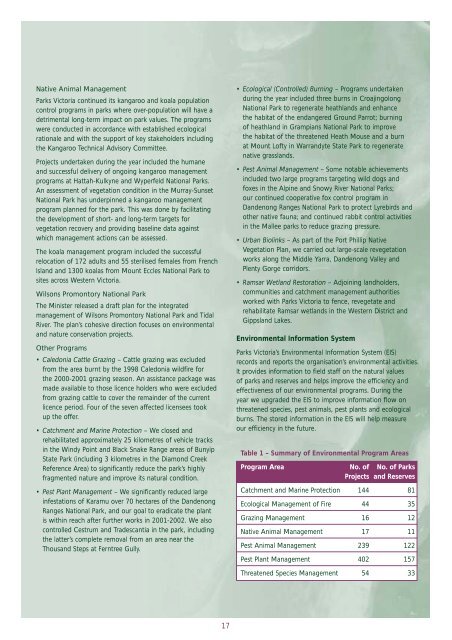Parks Victoria Annual Report 2000-01
Parks Victoria Annual Report 2000-01
Parks Victoria Annual Report 2000-01
- No tags were found...
You also want an ePaper? Increase the reach of your titles
YUMPU automatically turns print PDFs into web optimized ePapers that Google loves.
Native Animal Management<strong>Parks</strong> <strong>Victoria</strong> continued its kangaroo and koala populationcontrol programs in parks where over-population will have adetrimental long-term impact on park values. The programswere conducted in accordance with established ecologicalrationale and with the support of key stakeholders includingthe Kangaroo Technical Advisory Committee.Projects undertaken during the year included the humaneand successful delivery of ongoing kangaroo managementprograms at Hattah-Kulkyne and Wyperfeld National <strong>Parks</strong>.An assessment of vegetation condition in the Murray-SunsetNational Park has underpinned a kangaroo managementprogram planned for the park. This was done by facilitatingthe development of short- and long-term targets forvegetation recovery and providing baseline data againstwhich management actions can be assessed.The koala management program included the successfulrelocation of 172 adults and 55 sterilised females from FrenchIsland and 1300 koalas from Mount Eccles National Park tosites across Western <strong>Victoria</strong>.Wilsons Promontory National ParkThe Minister released a draft plan for the integratedmanagement of Wilsons Promontory National Park and TidalRiver. The plan’s cohesive direction focuses on environmentaland nature conservation projects.Other Programs• Caledonia Cattle Grazing – Cattle grazing was excludedfrom the area burnt by the 1998 Caledonia wildfire forthe <strong>2000</strong>-20<strong>01</strong> grazing season. An assistance package wasmade available to those licence holders who were excludedfrom grazing cattle to cover the remainder of the currentlicence period. Four of the seven affected licensees tookup the offer.• Catchment and Marine Protection – We closed andrehabilitated approximately 25 kilometres of vehicle tracksin the Windy Point and Black Snake Range areas of BunyipState Park (including 3 kilometres in the Diamond CreekReference Area) to significantly reduce the park’s highlyfragmented nature and improve its natural condition.• Pest Plant Management – We significantly reduced largeinfestations of Karamu over 70 hectares of the DandenongRanges National Park, and our goal to eradicate the plantis within reach after further works in 20<strong>01</strong>-2002. We alsocontrolled Cestrum and Tradescantia in the park, includingthe latter’s complete removal from an area near theThousand Steps at Ferntree Gully.• Ecological (Controlled) Burning – Programs undertakenduring the year included three burns in CroajingolongNational Park to regenerate heathlands and enhancethe habitat of the endangered Ground Parrot; burningof heathland in Grampians National Park to improvethe habitat of the threatened Heath Mouse and a burnat Mount Lofty in Warrandyte State Park to regeneratenative grasslands.• Pest Animal Management – Some notable achievementsincluded two large programs targeting wild dogs andfoxes in the Alpine and Snowy River National <strong>Parks</strong>;our continued cooperative fox control program inDandenong Ranges National Park to protect Lyrebirds andother native fauna; and continued rabbit control activitiesin the Mallee parks to reduce grazing pressure.• Urban Biolinks – As part of the Port Phillip NativeVegetation Plan, we carried out large-scale revegetationworks along the Middle Yarra, Dandenong Valley andPlenty Gorge corridors.• Ramsar Wetland Restoration – Adjoining landholders,communities and catchment management authoritiesworked with <strong>Parks</strong> <strong>Victoria</strong> to fence, revegetate andrehabilitate Ramsar wetlands in the Western District andGippsland Lakes.Environmental Information System<strong>Parks</strong> <strong>Victoria</strong>’s Environmental Information System (EIS)records and reports the organisation’s environmental activities.It provides information to field staff on the natural valuesof parks and reserves and helps improve the efficiency andeffectiveness of our environmental programs. During theyear we upgraded the EIS to improve information flow onthreatened species, pest animals, pest plants and ecologicalburns. The stored information in the EIS will help measureour efficiency in the future.Table 1 – Summary of Environmental Program AreasProgram Area No. of No. of <strong>Parks</strong>Projects and ReservesCatchment and Marine Protection 144 81Ecological Management of Fire 44 35Grazing Management 16 12Native Animal Management 17 11Pest Animal Management 239 122Pest Plant Management 402 157Threatened Species Management 54 3317

















